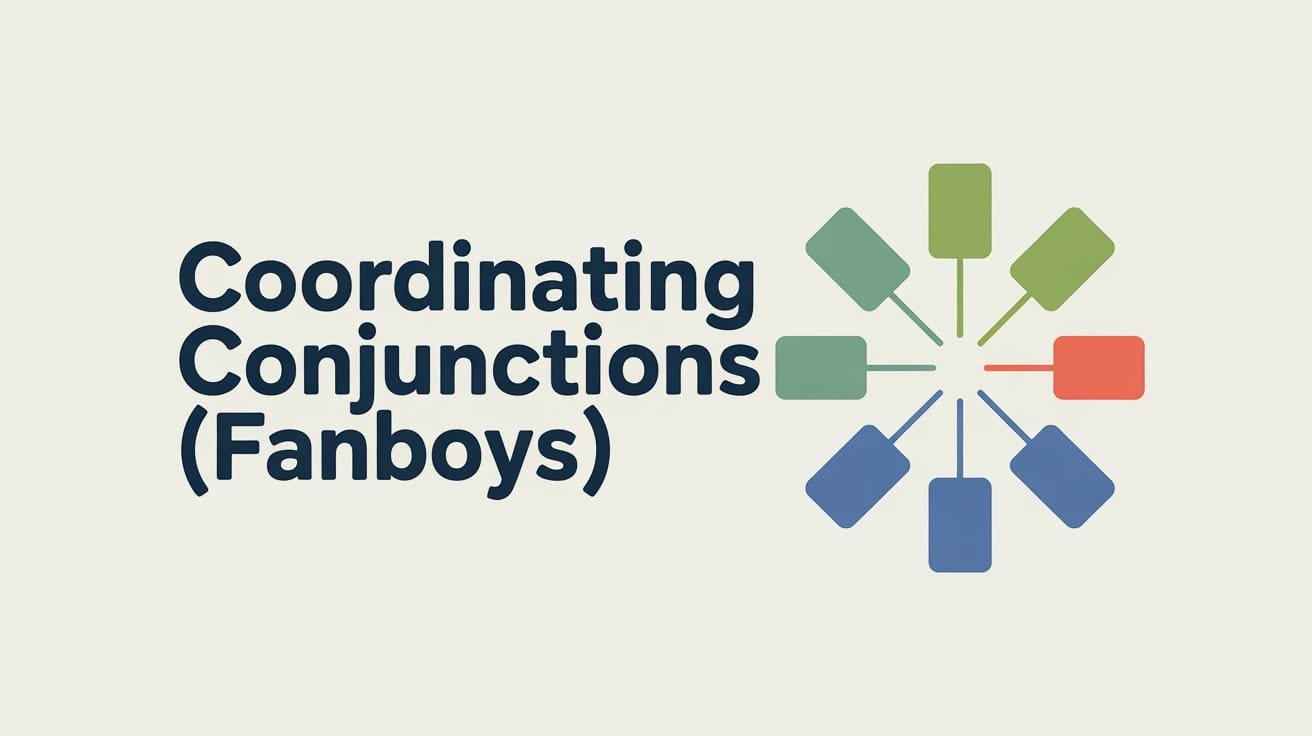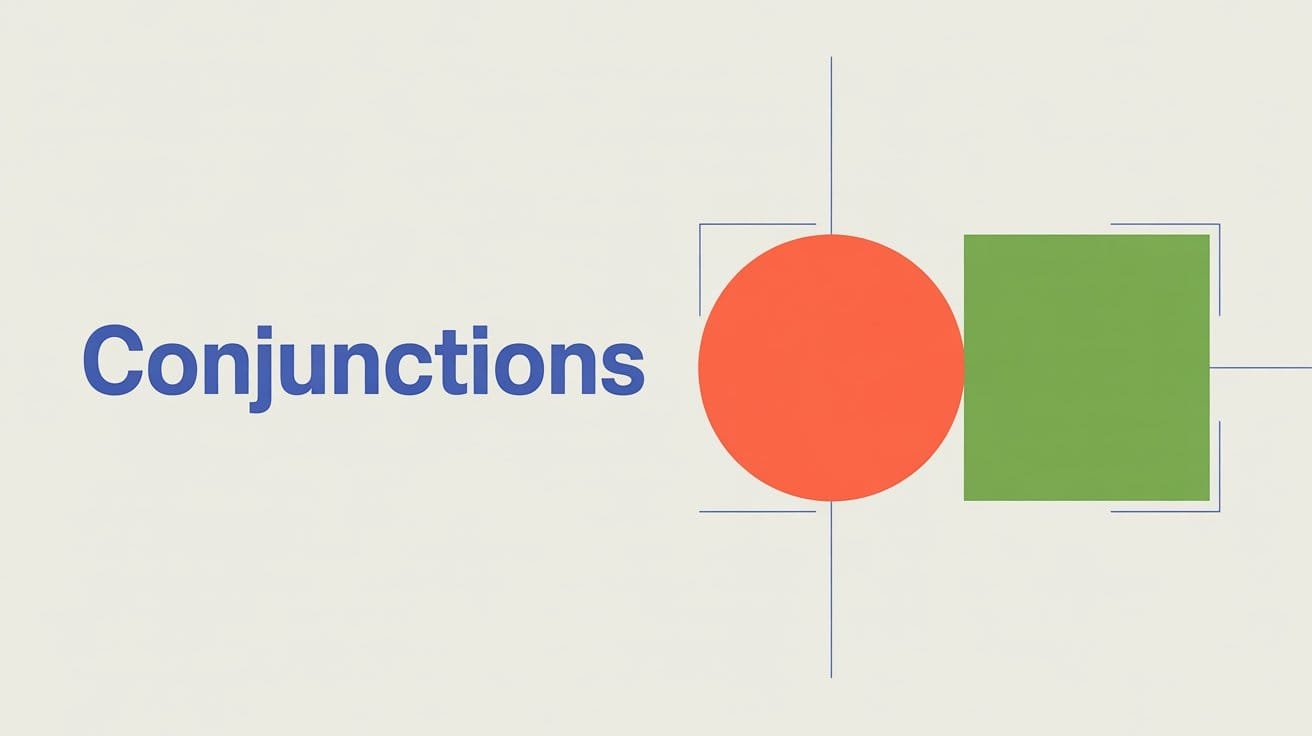When two ideas have equal importance, you need a simple way to connect them smoothly. That’s where coordinating conjunctions come in. They join ideas that share the same grammatical weight, helping sentences flow naturally instead of sounding abrupt or repetitive. The seven coordinating conjunctions are: For, And, Nor, But, Or, Yet, So. You can easily remember them through the acronym FANBOYS.
What Are Coordinating Conjunctions?
A coordinating conjunction is a word that joins two or more elements of equal grammatical importance in a sentence. These elements can be words, phrases, or independent clauses that carry the same function or level in sentence structure.
Examples:
- The room was bright and quiet. → joins two adjectives
- We waited for the bus, but it never came. → joins two independent clauses
- She can swim or dive. → joins two verbs
Coordinating conjunctions act as bridges between related ideas. They show relationships such as addition, contrast, choice, reason, or result without making one idea subordinate to another.
Unlike subordinating conjunctions (which create dependence), coordinating conjunctions keep ideas balanced and equal.
For instance:
I studied hard, so I passed the test.
Both parts are independent and could stand alone, but the conjunction connects them smoothly.
The FANBOYS Acronym Explained
English has only seven coordinating conjunctions, but they appear constantly in writing and speech. To remember them easily, teachers and grammarians use the acronym FANBOYS—For, And, Nor, But, Or, Yet, So.
Each of these words connects ideas differently. Some add information, others contrast, offer choices, or show results. They link thoughts that are grammatically equal but logically distinct, keeping your sentences balanced and your meaning clear.
For — Expressing Reason or Cause
For connects two ideas by showing why something happens. It works much like because, but it’s slightly more formal and less common in everyday speech.
Examples:
- The students stayed behind, for they had to complete the project report.
- The park was empty, for it had started to rain.
- The hikers turned back, for the trail had become unsafe after the storm.
- She stayed silent, for she didn’t want to interrupt the meeting.
Tip: Place a comma before for because it connects two independent clauses. Avoid using it for “purpose” (that’s what to or so that are for).
And — Adding Information or Ideas
And joins similar ideas or adds new details. It’s the most frequently used coordinating conjunction in English.
Examples:
- She packed her camera and tripod for the trip.
- The cafe is cozy and affordable.
- The report was detailed and accurate.
And can also connect longer clauses, helping them flow naturally:
- I finished the report early, and I submitted it before leaving for lunch.
Tip: When joining two independent clauses with and, place a comma before it. Avoid overusing and in long chains of ideas; it can make sentences feel heavy or repetitive.
Nor — Linking Two Negative Ideas
Nor is used to add a second negative idea to a statement. It usually follows neither or a negative verb, maintaining a formal tone.
Examples:
- The guests didn’t arrive, nor did they send a message.
- She doesn’t eat meat, nor does she drink milk.
- They didn’t agree to the terms, nor did they offer an alternative.
Tip: When using nor, invert the subject and verb that follow it (nor did they, nor was he). This makes the sentence grammatically correct.
But — Showing Contrast or Opposition
But introduces a contrast between two ideas that are opposite in meaning or expectation.
Examples:
- The proposal looked risky, but it turned out successful.
- He worked hard, but he missed the final deadline.
- The book looks simple, but its message is profound.
But is short and direct, making it the most common conjunction for contrast. Avoid replacing it unnecessarily with longer phrases like however unless the sentence structure demands it.
Or — Presenting a Choice or Possibility
Or offers options, alternatives, or possibilities between two or more ideas.
Examples:
- You can pay in cash or by card.
- We can meet today or postpone it until Monday.
- You can start now, or wait until the instructions are clear.
Or can also introduce consequences:
- Hurry up, or you’ll miss the train.
- Be careful, or you’ll drop it.
Tip: The comma before or is necessary only when connecting two independent clauses.
Yet — Indicating an Unexpected Contrast
Yet expresses contrast with a sense of surprise, something contrary to what might be expected. It’s stronger in tone than but and often appears in formal or descriptive writing.
Examples:
- The solution was simple, yet no one noticed it.
- He’s new to the company, yet he already leads the team.
- The painting looked chaotic, yet it captured a clear emotion.
Tip: Yet works best when you want to highlight contrast with a hint of surprise or contradiction.
So — Showing Result or Effect
So introduces the result or consequence of the first idea. It’s often used in place of therefore in everyday writing.
Examples:
- The forecast predicted rain, so the match was canceled.
- She studied the material carefully, so she passed with confidence.
Tip: Avoid using so together with that when it already connects two clauses.
Incorrect: She was tired, so that she went to sleep early.
Correct: She was tired, so she went to sleep early.
Rules for Using Coordinating Conjunctions
Coordinating conjunctions may look simple, but using them correctly keeps sentences clear and grammatically balanced. These rules will help you connect ideas smoothly without creating fragments or run-on sentences.
Use a Comma When Joining Two Independent Clauses
When a coordinating conjunction connects two independent clauses (each with its own subject and verb), a comma should come before the conjunction. Think of the comma as a small pause that separates two complete ideas.
Correct: We left early, but the concert hadn’t started.
Incorrect: We left early but the concert hadn’t started.
Skip the Comma When Joining Short Words or Phrases
When you’re connecting single words or short phrases, you don’t need a comma. Adding a comma would interrupt the natural flow of the sentence.
- She bought apples and oranges.
- We can stay home or go out tonight.
Avoid Comma Splices
Never connect two independent clauses with just a comma. This error is known as a comma splice. A coordinating conjunction or proper punctuation must be used to separate the clauses correctly.
Incorrect: He studied hard, he passed the exam.
Correct: He studied hard, so he passed the exam.
Correct: He studied hard. He passed the exam.
Keep Sentence Parts Equal
The parts joined by a coordinating conjunction should be grammatically parallel—nouns with nouns, verbs with verbs, or clauses with clauses.
Maintaining equal structure makes sentences smoother and easier to understand.
Incorrect: She likes reading and to write stories.
Correct: She likes reading and writing stories.
Don’t Use More Than One Coordinating Conjunction Between Clauses
Only one conjunction is needed to connect two ideas. Doubling them can make a sentence confusing or ungrammatical.
Incorrect: He missed the meeting but yet sent his notes later.
Correct: He missed the meeting, yet sent his notes later.
Use a Period Instead of a Conjunction When Ideas Don’t Relate
If the two clauses express unrelated ideas, separate them into two sentences instead of forcing a connection.
Incorrect: The printer jammed, and I prefer iced coffee.
Correct: The printer jammed. I prefer iced coffee.
Use Conjunctions at the Beginning for Emphasis (Sparingly)
Starting with and, but, or so can make writing sound natural or conversational, but use this style only when you want emphasis.
Examples:
- The project seemed impossible. But the team succeeded.
- I reviewed the data again. And the results were consistent.
Using these rules ensures that your coordinating conjunctions add clarity, not confusion.
Quick Reference Table (FANBOYS Summary)
| Conjunction | Function / Meaning | Example Sentence |
|---|---|---|
| For | Shows reason or cause | The streets were quiet, for everyone had gone home. |
| And | Adds or combines ideas | She bought notebooks and markers for class. |
| Nor | Adds a negative idea to another | He doesn’t drive, nor does he own a car. |
| But | Shows contrast or opposition | The play was long, but it held everyone’s attention. |
| Or | Expresses choice or alternative | You can take the train or wait for the bus. |
| Yet | Indicates an unexpected contrast | The path looked steep, yet it was easy to climb. |
| So | Shows result or effect | It began to rain, so they canceled the picnic. |
FAQs About Coordinating Conjunctions
What are coordinating conjunctions?
Coordinating conjunctions are words that join two or more elements of equal importance — such as words, phrases, or independent clauses. Example: She wanted coffee, but the shop was closed.
What does FANBOYS stand for?
FANBOYS is an acronym for the seven coordinating conjunctions: for, and, nor, but, or, yet, so.
When should I use a comma with coordinating conjunctions?
Use a comma before the conjunction when it joins two independent clauses. Example: He missed the train, so he took a cab instead. Skip the comma when connecting short phrases or single words.
Is “so that” a coordinating conjunction?
No. So that is a subordinating conjunction, not a coordinating one. It introduces a purpose clause. Example: She left early so that she could catch the bus.
What’s the difference between “but” and “yet”?
Both show contrast, but yet often adds a sense of surprise or unexpected outcome.
Example: He was exhausted, yet he continued running.
Example: He was exhausted, but he continued running. (less emphasis on surprise)
How is “for” used as a conjunction?
When used as a coordinating conjunction, for means “because” or “since.”
Example: The flight was delayed, for the weather turned bad.
It does not indicate purpose (unlike for as a preposition in for work).
What’s the difference between coordinating and subordinating conjunctions?
Coordinating conjunctions connect equal parts (e.g., two full sentences). On the other hand, subordinating conjunctions make one part dependent on the other.



